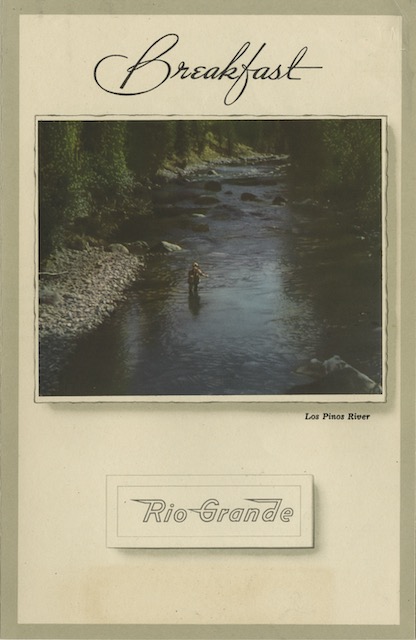The Los Pinos River, sometimes called the Pine River, flows out of what is now the Wenimuche Wilderness Area near Durango, Colorado. This wilderness is nearly half a million acres in size, and one of its trail heads is only accessible by taking the Durango & Silverton Narrow Gauge Railroad to a stop known as Needleton.
 Click image to download a 851-KB PDF of this menu.
Click image to download a 851-KB PDF of this menu.
The “n” in Pinos should have a tilde (~) over it, signifying that it is pronounced “peenyos,” but Coloradans aren’t very respectful of Spanish names — they pronounce the town of Buena Vista “byuna vista.” The front cover of this menu identifies the photo as Los Pinos River, while the back calls it the Pine River. Either name might be found on maps of the area.
Although this menu is dated March, 1946, it still implores people to buy war bonds and still guarantees that menu prices follow federal wartime price controls. The menu includes a wide range of foods, indicating that any wartime shortages were over. For $1.25, diners could order a “native mountain trout,” but for only $1.00, they could have a full meal with “panned filet of fresh fish” as an entrée, along with fruit or cereal, bread, and beverage. The “fresh fish” must not have been native to Colorado mountains.
This menu had been chopped up, probably by the Rio Grande’s commissary, so it could be inserted into a notebook. I was able to restore the basic appearance, but the colors in the restored areas don’t exactly match the original.

I don’t thin it’s a matter of being respectful so much as it is being uninformed. To expect English speaking people back then to know the rules of Spanish pronunciation would be like expecting a native Spanish speaker to know the proper pronunciation of the word “sprinkler.” The “ler” sound does not exist in Spanish, so it gets pronounced “sprinkle.”
It can also be a typographical issue. For decades, AP for one didn’t use tildes or other special characters because the teletype machines didn’t have them.